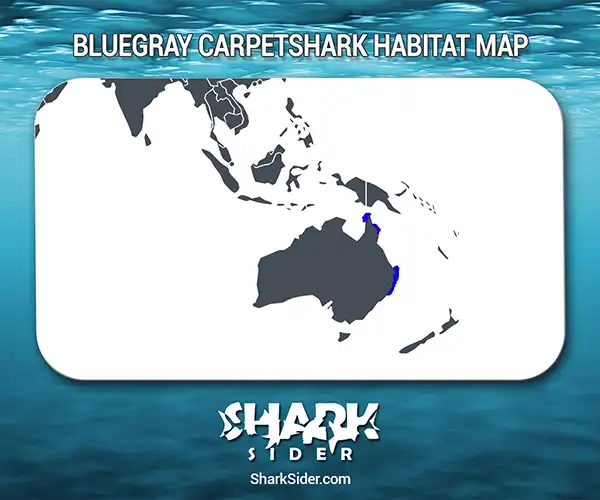Australia’s northeastern coast is home to this small and uncommon bottom-dweller, known as Brachaelurus Colcloughi. It is a prime example of the ordinary, poorly known species that are easily forgotten when it comes to shark conservation. Yet these cryptic critters are just as important to marine ecosystems as the big, flashy sharks that grab all the attention.
In Romeo and Juliet, William Shakespeare wrote “a rose by any other name would smell as sweet”. Well, this species is your perfect shark example of why the nature of something is more important than its name! It also shows why Latin names are important when we’re taking about organisms.
Common names can lead to confusion. Some people do call this “Bluegray Carpetshark”. However others call it “Colclough’s Shark”. With two names that are like apples and oranges, you’d never know they refer to the exact same beast! This species is also referred to as blue-grey catshark, Bluegrey Shark, or southern blind shark. If you’re French you’d call it Requin aveugle gris-bleu, or in Spanish it’d be Tiburón ciego gris.
Unfortunately, in this case even the scientific name can be misleading, because the species is sometimes placed in another genus: so it is also known as Heteroscyllium Colcloughi. Whatever we call it, this shark is one of only two species of “blind sharks” (Family Brachaeluridae), which in turn belong to the broader grouping known as “carpet sharks” (Order Orectolobiformes).
Bluegray Carpetshark Facts
Blind sharks like this are so named because they close their eyes when taken out of the water.
This one is considered a rare species, as it is seldom observed, despite decades of fish surveying across its range.
This Carpetshark is a stocky fish with eyes positioned toward the top of its wide, flattish head. It has a blunt snout, and a pair of long fleshy projections known as “Barbels” hang down either side of its small mouth, in front of the nostrils. It has large pectoral fins, and dorsal fins placed far back on the body, with the first being larger than the second.
Young sharks have distinct black markings on a white background, a pattern that fades to brownish in adults. The average size is 40 to 50 cm (16 to 20″), with a maximum recorded length of 85 cm (33″).
Habitat and Range
Map Of The Bluegray Carpet Shark’s Habitat

This species is found along the continental shelf of the northeastern coast of Australia, in New South Wales and in Queensland, including on the Great Barrier Reef. This is one of the few sharks that occurs mainly around an urban area (off southeastern Queensland).
It is usually observed in shallow, inshore waters, often at around 5 m (17″) and regularly up to 100 m (333 ft) deep, though it has been recorded down to 217 m (723 ft). During the day it hides in reefs, under rocky ledges and in caves, and has also been seen hanging around shipwrecks.
Feeding Behavior
The Bluegray Carpetshark likely comes out from its hiding spots to forage at night. While little is known about the diet, based on close relatives it is thought to feed on other bottom-dwelling invertebrates and small bony fish.
Social Behavior
No information was encountered about this shark’s general behavior.
Breeding
The breeding method is known as Ovoviviparous. In this situation the egg cases of the embryos disappear early in development, while they are still inside the mother. The young continue to be nourished by yolk, until they are born free.
A female has a litter of 6 to 8 pups, which are about 18 cm (7″) long at birth.
There is no information about the age at maturity or the lifespan of this species.
Humans and Conservation
Urban coastal areas like the one where this species lives are often the site of human activities that harm fish: industry, recreation, and habitat disturbance can have a negative impact on shark populations.
The ocean home of the Bluegray Carpetshark does experience intensive fishing and development. This species is caught accidentally by trawling (a fishing method where nets are dragged behind a boat), and then sold in the aquarium trade. It is popular for that purpose because young sharks have an attractive coloring, and they seem to adapt well to captivity. Pollution is also a potential threat.
These sharks are harmless to people. The Red List of the International Union for Conservation of Nature names this species as Vulnerable because it has a small range in a densely populated area, limited habitat preferences, and it is uncommon.
Populations are being monitored but no specific conservation actions are in place. The habitat type that is essential for this species is inner coastal reefs. Degradation of these reefs means that less area is available for the species. Some of the critical habitat is protected on the Great Barrier Reef and within Moreton Bay Marine Park.
Like other uncommon sharks, another important challenge for management of this creature is the lack of basic information about its life history.
Sources
Arkive
Kyne PM, Compagno LJV, Stead J, Jackson MV & Bennett MB (2011). Distribution, habitat and biology of a rare and threatened eastern Australian endemic shark: Colclough’s shark, Brachaelurus colcloughi Ogilby, 1908. Marine and Freshwater Research 62: 540-547.
Pogonoski JJ, Pollard DA & Paxton JR (2002). Conservation Overview and Action Plan for Australian Threatened and Potentially Threatened Marine and Estuarine Fishes. Published by Environment Australia
